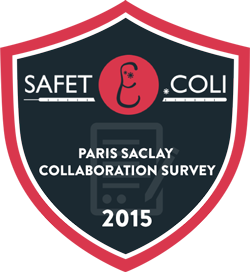Difference between revisions of "Template:Team:TU Eindhoven/Overview HTML"
| Line 16: | Line 16: | ||
An approach to diagnose disease is through the use of analytical instruments. Even though these instruments provide rich information which can lead to sound diagnoses, analytical instruments suffer from long processing and waiting times, as samples often need to be pre-treated and the instruments are frequently occupied. To overcome the long processing and waiting times, biosensors have been developed. These biosensors can be used on-site and are easy-to-use, but a universal approach in these biosensors is lacking. That is where we come in, as we have developed <span class="tekst1B">a universal membrane sensor platform for biosensors</span>, which we call Clickable Outer Membrane Biosensors (COMBs). | An approach to diagnose disease is through the use of analytical instruments. Even though these instruments provide rich information which can lead to sound diagnoses, analytical instruments suffer from long processing and waiting times, as samples often need to be pre-treated and the instruments are frequently occupied. To overcome the long processing and waiting times, biosensors have been developed. These biosensors can be used on-site and are easy-to-use, but a universal approach in these biosensors is lacking. That is where we come in, as we have developed <span class="tekst1B">a universal membrane sensor platform for biosensors</span>, which we call Clickable Outer Membrane Biosensors (COMBs). | ||
</span></span> | </span></span> | ||
| + | |||
| + | <div id="linksToDetailsHolder"> | ||
| + | <div class="link"> | ||
| + | <img class="linkImg" src="https://static.igem.org/mediawiki/2015/8/84/Paris_Saclay_survey-badge.png" alt="iGEM Paris-Saclay Collaboration Survey Badge"/> | ||
| + | <div class="linkTxt"><span class="tekst1">This beautiful badge was awarded to us after we filled in Paris-Saclay's survey.</span></div> | ||
| + | </div> | ||
| + | <div class="link"> | ||
| + | <a href="http://igem.rhizi.net/rz/iGEM%20Rhizi%202015" target="_blank"><img class="linkImg" src="https://static.igem.org/mediawiki/2015/c/ce/TU_Eindhoven_Rhizi_Badge.png" alt="iGEM Paris-Bettencourt Rhizi Badge"/></a> | ||
| + | <div class="linkTxt"><span class="tekst1">We connected our iGEM Project to Paris-Bettencourt's Rhizi. Click the badge to view the Rhizi.</span></div> | ||
| + | </div> | ||
| + | </div> | ||
| + | |||
</html> | </html> | ||
Revision as of 13:46, 12 September 2015
Clickable Outer Membrane Biosensors (COMBs)
- An aptamer-based approach to a universal and modular biosensor platform
Ground-breaking drug discoveries are at the forefront of society. The success rate of curing, however, highly depends on an accurate and early diagnosis of disease
An illustrating example is intestinal cancer. The survival rate of patients diagnosed with intestinal cancer in the early stage is 90%, whereas the survival rate of patients diagnosed in the critical stage is a meagre 13% [1]. An accurate and early diagnosis saves lives.
An approach to diagnose disease is through the use of analytical instruments. Even though these instruments provide rich information which can lead to sound diagnoses, analytical instruments suffer from long processing and waiting times, as samples often need to be pre-treated and the instruments are frequently occupied. To overcome the long processing and waiting times, biosensors have been developed. These biosensors can be used on-site and are easy-to-use, but a universal approach in these biosensors is lacking. That is where we come in, as we have developed a universal membrane sensor platform for biosensors, which we call Clickable Outer Membrane Biosensors (COMBs).

